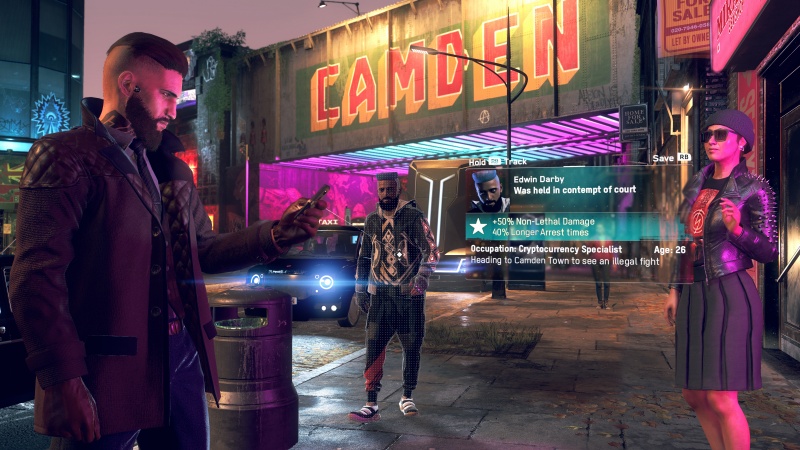
In the case of Ubisoft Toronto’s Watch Dogs: Legion, though, this statement is actually quite valid.
Formally unveiled at the Electronics Entertainment Expo (E3) this week, Legion is the third entry in Ubisoft’s hacking-centric Watch Dogs action-adventure series. The game is set in a near-future, post-Brexit London that’s been taken over by an authoritarian regime. DedSec, the hacktivist group from the first two Watch Dog games, is looking to fight back by recruiting as many Londoners as possible and start a revolution.
Unlike the previous Watch Dogs titles, Legion doesn’t give you a pre-defined character to use, nor does it offer the ability to create an avatar of your own. Instead, through a remarkably innovative gameplay system that was certainly a nightmare to develop, Ubisoft Toronto is actually allowing you to play as anyone in the game world.
This means that every non-player character (NPC) — be it the meek businessman in the financial district, the suave street performer or elderly woman feeding the birds in the park — can join your cause. Moreover, each NPC has their own tweaked voiceovers, dialogue and animations to make using them feel just a bit more personal.
In terms of how this all works, Legion actually builds upon a relatively minor mechanic from its predecessors in a wonderfully clever way. In those games, the world would get fleshed out through random bios that could be read while scanning an NPC with your phone. In Legion, these bios serve as the basis for the scouting process and, through that, a variety of branching gameplay experiences.
Find a woman that’s desperate for a new kidney? Head over to the hospital to hack its computer systems, put her first on the transplant list and get her ready for action. Come across a man whose girlfriend is in prison? Mount a jailbreak to rescue her and win her beau to your side. Stumble upon a bored pub dweller? Befriend him over a game of darts.
These are only some of the backstories for people that I saw or heard about during my demo. Altogether, there is an open-ended number of possibilities of both the violent and non-violent variety — so many, in fact, that Ubisoft Toronto hasn’t been able to provide an estimate as to just how many there may be.
At any time, you can also save a person’s info into your phone to find them later — a particularly welcome feature if you’re in the middle of a mission. After roughing up a DedSec candidate’s harasser, I had stored about 10 other potential recruits that I was able to go back and assess. Each NPC has a routine that they follow, with activities being carried out at various times and locations depending on the person. By tagging them in your phone, you’ll be able to track them down later for recruitment using the knowledge of what they’re up to.
Keeping tabs on a variety of people can be especially useful since they each have unique attributes to make them stand out, such as greater resistance to drone attacks or being able to deal more damage when their health is low. Once recruited, characters can be levelled up by completing missions and side activities to open up additional tools and abilities.
Further, you can choose to assign a character in one of three classes — combat, stealth or hacking — to focus their abilities into one specialty area. When married to the wide-ranging lineup of characters and their unique attributes, the class system truly capitalizes on Ubisoft’s classic sandbox-style approach to missions.
As the hacker class, I was able to shack up behind a car and alternate between using a remote-controlled spider robot and security cameras to hack my way into locked areas. Pulling off the perfect heist without even setting foot in the building is an immensely satisfying feeling.
Alternatively, with a stealth operative, I could have taken control of an overhead large delivery drone, use it to fly Green Goblin-style up to a vantage point and then use my visibility-reducing skills to sneak around nearby guards. Likewise, I could have used a combat agent who takes less damage from turrets to run in guns blazing.
Choosing the appropriate character to use is critical because permadeath is enabled in Legion, meaning that once a character dies, they’re gone for good. This adds a really engaging risk-reward element to the game. You can send in a higher-level agent to better help you hack your way through a dangerous area, but you’ll never get her back if she gets taken down.
At the same time, you’ll need to consider if you want to take a non-lethal approach. Should you get into a shootout and take down a number of hostiles, you’ll not only eliminate the potential to recruit them in the future, but you’ll have also hurt your chances with others to whom they’re related.
For example, John Doe the security guard might have friends, family and other associates who are represented through in-game NPCs. If John is killed, his loved ones will remember what DedSec has done and the possibility of them ever joining you will be made all the less likely or even non-existent.
All of these mechanics are seemingly shaping up well, so my only real concern for Legion is simply how stable it will be at launch. My hands-on time was remarkably polished, to be sure, and Ubisoft still has a little under a year to continue to iron out the kinks.
Even still, games with a fraction of this level of ambition — including those from Ubisoft Toronto sister studios like the first Watch Dogs and Assassin’s Creed Unity — have suffered from many bugs, so I’m praying for a smooth launch for Legion.
As it stands, the game shows genuine originality and incredible promise, and I’m eager to see how it all plays out. We’ll find out for sure when Legion releases on March 6th, 2020 on PlayStation 4, Xbox One, PC and Google’s Stadia streaming service.
MobileSyrup may earn a commission from purchases made via our links, which helps fund the journalism we provide free on our website. These links do not influence our editorial content. Support us here.






